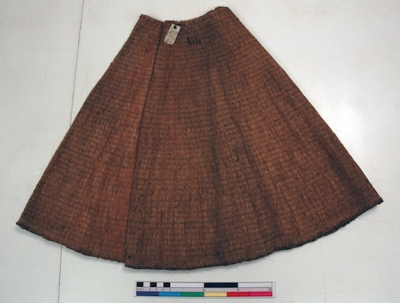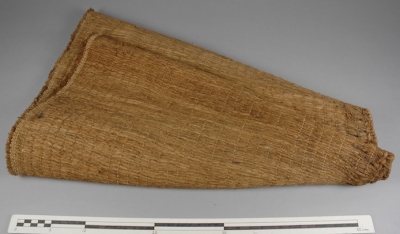Cedar bark cape 1884.140.1047
Madeleine Ding, Cataloguer, Pitt Rivers Museum
This cedar bark cape was made on the Northwest coast of America. The cape is made in a continuous round of twined cedar bark. The label relating to this object states it was obtained on the west coast of Vancouver Island. Vancouver Island is a large island off the coast of British Columbia, Canada, whose west coast is the traditional home to the Nuu-chah-nulth tribe.
The cape is mentioned in two original record books; Delivery Catalogue I page 62 and Green book (a book written at Bethnal Green and South Kensington Museums as Pitt-Rivers loaned items to those museums) page 168.5844. However, until recently the location of the cape was unknown. The cape was recently relocated and given an entry in a new Pitt Rivers Accession book PR IX on page 25. The documentation is as follows:
PR IX accession entry - NORTH AMERICA, CANADA, BRITISH COLUMBIA. Cedar bark cloak. Found unentered at Osney with plant fibre clothing. Found with PR number inscribed on the object "211/ 12099". This number matched the record on PRM possibles for a cedar bark cloak so the cloak was therefore accessioned with an 1884.140 accession number.[FC 5/10/2010]
Delivery Catalogue I entry - Miscellaneous objects principally wearing apparel Case 69 Cedar bark cape Vancouver Island 211/ 12099 73 Case 69
'Green book' entry - South Kensington Receipts, 18 March 1881 - The objects numbered 1 to 292 [?that is, numbers assigned by Pitt Rivers] .... 211 Cedar bark Indian cape Vancouver Island West coast
The cape was identified by a pre-Pitt Rivers Museum label attached to the object ‘CEDAR BARK INDIAN CAPE FROM THE TRIBES OF THE WEST COAST OF VANCOUVER ISLAND OBT. BY DR W. F. DALLY. [on reverse of label] 211/ 12099’. Also written on the object was the number ‘211/ 12099’. This unique number referred only to this object.
The cape is made of cedar bark. The cedar tree is a very important plant to peoples of the Northwest coast. As the famous carver Bill Reid says cedar is a ‘source of some of the finest materials for making objects of use and beauty’. (Stewart, 1984: 9). The wood is used for buildings, poles, canoes and boxes, the bark for baskets, matting and clothing, the roots for baskets and hats and the withes for ropes.
Cedar bark is used in outer clothing to keep dry and warm. In the damp environment of the northwest coast the bark is quick drying and layers provide insulation. According to Hilary Stewart (1984) capes like the one in our collection were worn by women. The job of collecting bark from cedar trees in the forest was a woman’s task.
Bark was taken from trees when the sap was running, during spring time (Stewart 1975: 88). The bark is removed in long strips. The inner lighter bark is removed from the tougher outer bark. The inner bark is beaten (with stones) to make it softer. Stewart (1975: 88) records and illustrates the bark shredder tools used to work the fibre. The fibre is used in strands and strips for making “coarse woven products such as mats, baskets and shawls”. (Gerber 1989: 51)
The cape would have been woven on an A-frame. The strips of shredded bark are hung over a circular cord and twined in place. The cape has a continuous length of single twining with rows every 10 to 15 mm. To make the shoulder cape flare out extra bundles of shredded cedar bark are added (Stewart, 1984; 144) only visible on the inside.
Dr Frederick Dally was the first recorded owner of the cape. Dally was an English man working as a professional photographer in Victoria on Vancouver Island. He lived in British Columbia between 1862 and 1870 (National Library and Archives, Canada). Joan Schwartz (Canada Encyclopedia) records Dally was ‘a keen observer and amateur anthropologist, Dally photographed the coast and interior tribes and also collected native artifacts’. Dally returned to the UK after undertaking dentistry training to work as a dentist. Lt. Col. Pitt Rivers acquired the cape along with 51 other objects collected by Dr Dally.
The cape was delivered to South Kensington Museum in March 1881 and was probably displayed between 1881 and 1884. This object was listed in the Delivery Catalogue as having been transferred from South Kensington Museum in 1884. The cape has been at the Pitt Rivers Museum, Oxford since 1884.
There is a similar twined cedar bark poncho-style cape on display in the Court, wall case 18 A. It’s accession number is 1961.9.1.
January 2011
Sources
Gerber, Peter R. (1989) Indians of the Northwest Coast, Facts on file: New York: Oxford, photographer Maximilien Bruggmann, translated Barbara Fritzemeier
Schwartz, Joan, Dally, Frederick http://www.thecanadianencyclopedia.com/index.cfm?PgNm=TCE&Params=A1ARTA0002114 [accessed 26/10/2010]
Mattison, David (1999-2000) Camera Workers: The British Columbia Photographic Directory, 1858-1950 - D - Volume 1 (1858-1900)
http://collection.nlc-bnc.ca/100/200/300/david_mattison/camera_workers/1999/cw1-d-names.html [accessed 02/12/2010]
Stewart, Hilary (1984) Cedar: tree of life to the Northwest Coast Indians, Douglas & McIntyre: Vancouver/Toronto
Stewart, Hilary (1975) Indian Artefacts of the Northwest coast, University of Washington Press: Seattle and London




